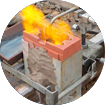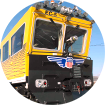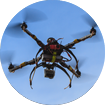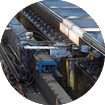Safety is Union Pacific's number one priority. Nothing is more important than the well-being and security of our employees and the people who reside in the communities where we live and work. Safe operations also are critical to meeting our customer commitments. We invest significant resources in training employees, developing innovative technologies and increasing rail safety awareness. Our ultimate goal is to operate an incident-free environment, which we aim to achieve by meeting safety milestones each year.
Operating Safely
Operating Safely
Shawn Patrick, car inspector
HIGHLIGHTS, CHALLENGES AND OPPORTUNITIES
Union Pacific became the safest U.S. Class I railroad in 2015, reducing our employee reportable injury rate to an all-time low. This is a significant accomplishment and a tribute to our employees who take ownership in making sure everyone goes home safely to their families.
Union Pacific's crossing accident rate improved to 2.28 accidents per million train miles, compared to 2.34 in 2014. We continue to enhance our Union Pacific Crossing Accident Reduction Education and Safety (UP CARES) program and reached new community members with comprehensive social media campaigns and other efforts that address rail safety.
Community Public Safety
UP CARES OUTREACH
Union Pacific's public safety volunteers conducted more than 15,000 rail safety presentations to more than 600,000 pedestrians, motorists and professional truck drivers across our 23-state network. Our special agents carried out 300 UP CARES education and enforcement operations, which involve observing driver behavior at railroad crossings with state and local police departments. More than 4,000 drivers were educated through these activities.
HIGH SCHOOL PHOTO SAFETY CAMPAIGN
Union Pacific launched its first exclusively social media-based campaign, urging photographers and high school seniors to stop taking photographs on or near train tracks. Through startling videos, the campaign compares the dangers of taking photos on the tracks to posing for senior pictures on a busy highway. Neither are safe locations. The campaign launched in June on social media channels including Facebook, Twitter, Instagram and YouTube. It achieved an audience reach of 170 million during its first five months, and the message was carried by leading photography industry websites. The campaign also was highlighted in a network television news story about the dangers of taking pictures on railroad tracks.
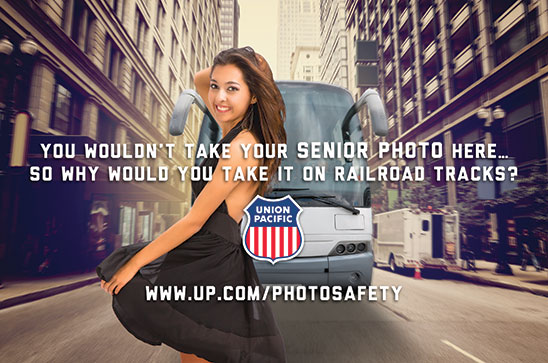
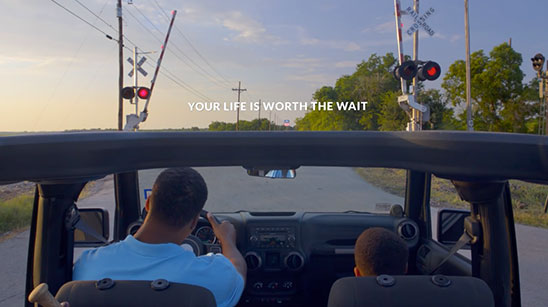
YOUR LIFE IS WORTH THE WAIT CAMPAIGN
It can be tempting to drive around lowered railroad gates to save a few minutes, but your life is worth the wait. This was the message behind the safety-awareness initiative we launched on YouTube, Facebook, Twitter and Instagram in October 2015. The campaign urges drivers and pedestrians to think about their safety first and wait at grade crossings. Videos depict different scenarios in which a jogger, a young couple and a father-and-son duo are stopped, waiting for a train to pass. When the crossing arms lift, each proceeds safely toward promising futures.
Community Event Notification
Union Pacific's highest priority is the safety of our employees and the communities we serve. For everyone's safety, Union Pacific strongly encourages event organizers to plan activities that avoid railroad tracks and property. Event organizers should call our Response Communications Center to notify us of events and activities that cross or take place near railroad tracks or property. Visit Community Event Notification for more information.
Crossing Assessments in Our Communities
NEW APPROACH ENHANCES SAFETY AT RAILROAD CROSSINGS
In our ongoing effort to enhance safety at railroad crossings in our communities, Union Pacific launched the Crossing Assessment Program (CAP). While all Union Pacific crossings are safe and meet federal standards, CAP uses data to identify railroad crossings that may benefit from further safety enhancements such as warning signs or road adjustments. Data analysis helps us determine if railroad crossings are candidates for Union Pacific funding to provide safety enhancements or road closures – expenses typically absorbed by states and municipalities. At private crossings, Union Pacific works closely with landowners to find access routes that avoid crossing railroad tracks.
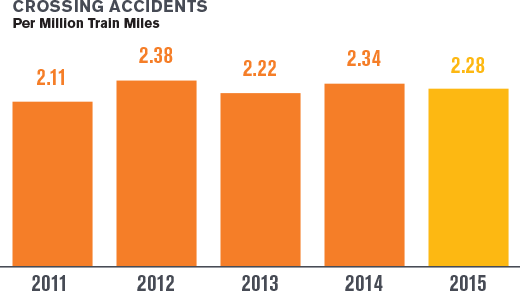
COLLABORATION ELIMINATES PUBLIC SAFETY RISK
Our CAP data analysis ranked a railroad crossing in Magna, Utah, as a location where a vehicle-train accident could occur. Drivers had to cross three sets of railroad tracks to get through the crossing that connected Rio Tinto Kennecott, a Union Pacific customer, with Salt Lake City and points beyond.
The CAP team further examined the private crossing and worked with representatives from Rio Tinto Kennecott to establish an alternate route. The private crossing was closed and vehicles were diverted to a road that parallels our tracks and onto a nearby overpass. Rio Tinto Kennecott's collaboration enhanced safety in the community and eliminated the risk of a potential accident.
RESPONSE MANAGEMENT COMMUNICATIONS CENTER
The Response Management Communications Center (RMCC) processes emergency and non-emergency calls from communities across our 23-state system. The RMCC team operates around the clock, responding to accidents, vehicles stuck on railroad tracks, criminal activities and any other concerns occurring on or near our tracks or property. Drivers and pedestrians can report emergencies or rail-related concerns to the RMCC through the phone number posted near railroad crossings, 888-UPRR-COP (877-7267).
Derailment Prevention
PERFORMANCE OVERVIEW
Union Pacific's top priority is to operate a safe, efficient and reliable railroad. While we made progress in public and employee safety, our reportable derailment incident rate per million train miles increased 14 percent, from 3.00 in 2014 to 3.42 in 2015. Our derailment prevention team investigates derailments to understand root causes and develop prevention initiatives to reduce accidents.
Union Pacific trains employees to inspect rail lines, equipment and bridges to prevent issues that could cause derailments. We also have more than 4,000 defect detector devices along the tracks, performing 20 million daily evaluations on our equipment and processing comprehensive analyses.
Customer Safety
Safety doesn't stop at the edge of our property. We also seek to support our customers in their efforts to employ safe practices at their facilities.
Last year, we developed an informational packet with photos to help customers identify and mitigate derailment risks posed by winter weather conditions, including floods, snow, ice and extreme cold, which can take a toll on track conditions. We included tips on how to spot and address potential problems at road and truck crossings, and industry switches, as well as best practices for preventive track maintenance. Additionally, during a period of extreme rain, we used our announcement system to remind customers that track conditions can be impacted by weather.
Employee Safety
PERFORMANCE OVERVIEW
Union Pacific recorded our best-ever employee safety performance for the second consecutive year. Our 2014 reportable injury rate was 0.98 injuries per 200,000 employee hours worked, and our 2015 reportable injury rate was 0.87 – an 11.2 percent improvement.
SAFETY STAND DOWNS SHOW COURAGE TO CARE
Union Pacific's dedication to safety is ever present. Our Courage to Care pledge represents our personal commitment to do our jobs with a passion for safety.
Departments and work groups continue to participate in volunteer systemwide "stand-down" meetings, during which normal operations are suspended so employees can speak candidly about unsafe behaviors, finding and eliminating risks, and improving the work environment so everyone returns home safely each day.
During October safety stand-down meetings, employees watched a video, "Courage to Care: It's Our Touchstone," highlighting the evolution of our commitment to safety and risk prevention. After the stand downs, employees were given the opportunity to provide feedback about their experience, so we can continue improving these important safety meetings.
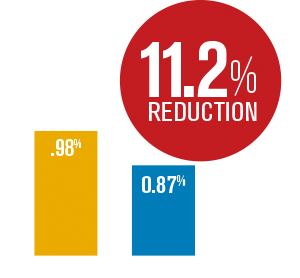
Injuries per 200,000 employee hours
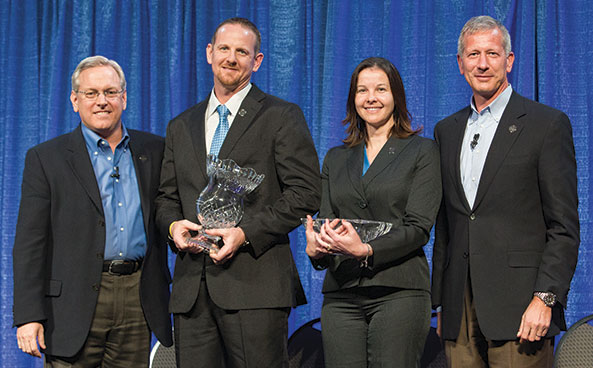
From left are Cameron Scott, executive vice president-Operations; David Matteson, conductor and peer trainer; Maria Matteson; and Chairman Lance Fritz.
KENEFICK SAFETY AWARD WINNER
David Matteson, a West Colton, California, conductor and peer trainer, was the 2015 recipient of Union Pacific's highest safety honor, the J.C. Kenefick Safety Award.
A 13-year railroad veteran, Matteson seized an opportunity to make an impact when he joined the peer trainer group in May 2013 and supported derailment prevention through hands-on training initiatives. His team provided derailment prevention training to more than 150 new hires, enhanced signage and implemented a remote-control locomotive training process. Matteson's efforts helped decrease Los Angeles Service Unit derailments by 74 percent and personal injuries by nearly 90 percent since 2007.
Incorporating Technology
Technology plays a fundamental role in our performance. We work with stakeholders, including suppliers, governmental organizations, employees, engineering researchers and others, as we explore and advance technological improvements.
LOCOMOTIVE SIMULATORS
Technology allows us to provide locomotive engineers with training in a controlled environment that simulates the experience of operating a locomotive along our tracks. Nearly 40 full-size locomotive simulators are in use systemwide and at our Technical Training Center in Salt Lake City. Locomotive engineers spent 17,000 hours training on the full-size locomotive simulators last year and 20,000 hours in 2014. Instructors in our Technical Training Center began providing real-time remote training from Salt Lake City to locomotive engineers across our system in 2015.
More than 200 Remote Controlled Locomotive (RCL) simulators are used to provide hands-on training for licensed operators. In their daily work, these operators use a small computer console located outside a locomotive to direct its movement in a rail yard. RCL simulator use increased from 5,000 hours in 2014 to more than 7,000 hours in 2015.
TELEMATICS
More than 3,600 company vehicles are outfitted with telematics. This technology uses a telecommunications device to provide feedback that encourages safe driving habits by transmitting real-time information about motorist behavior, including seat belt use, speed, acceleration and deceleration. Telematics reaffirms the importance of maintaining a steady safe speed, as opposed to rapid increases in speed or excessive braking, and is among tools we use to improve our fuel economy.
IN-CAB CAMERAS
We have more than 2,000 in-cab cameras installed in our locomotives. By the end of 2016, we expect to equip 5,000 locomotives with this technology. Inward-facing cameras complement the locomotive fleet's external-facing cameras, called Track Image Recorders (TIR), that have provided images of track, crossings and signals directly in front of locomotives since 2005. TIR video is used in conjunction with a locomotive's Event Recorder data, which includes train speed, throttle and brake settings, traction power levels, and horn use.
Through the years, TIR and Event Recorder data have validated the professionalism of train crews, and the same results are expected from inward-facing cameras. Proactive performance evaluations of video can increase understanding of crew behaviors, so training and coaching can be improved.
Using video technology to ensure safety, security and situational awareness is expanding in public places, government facilities and businesses. The rail industry reflects this worldwide trend, with cameras used in yardmaster towers, tunnels, shops, office buildings, crew vans, border locations and remote control locomotive crossings.
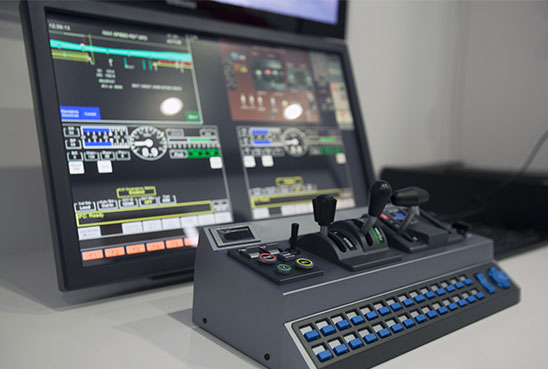
Engineers practice on simulators that replicate the operating experience inside locomotives.
Issue in Focus: Positive Train Control
Union Pacific is committed to implementing Positive Train Control (PTC) carefully and thoroughly to enhance the safety of our employees and the communities where we operate trains.
PTC is an advanced system designed to automatically stop a train before certain accidents occur. In particular, PTC is designed to prevent:
- Train-to-train collisions
- Derailments caused by excessive train speed
- Train movements through misaligned track switches
- Unauthorized train entry into work zones
PTC will not avert vehicle-train accidents at grade crossings, stop trains when people are walking on the track illegally, or prevent incidents due to railroad track or equipment malfunctions.
Through 2015, we invested just under $2 billion in PTC. Our current estimate for PTC's total cost is about $2.9 billion.
Developing and implementing PTC is a multi-part process requiring a systemwide approach and comprehensive testing once all the technologies are fully developed and installed.
PTC requires integrating thousands of components across the telecommunications spectrum, such as GPS, Wi-Fi, radios, cellular technology, antennae, base stations and first-of-its-kind software that decides when to slow or stop a train – across Union Pacific's network. PTC must be interoperable, meaning that passenger, commuter and freight trains are required to seamlessly communicate across all railroad systems.
When fully deployed, the nationwide PTC system will be able to accurately determine a train's location, direction and speed via the following process:
- An onboard computer system receives and analyzes track data from wayside locations and base-station radios along the planned route.
- This provides the locomotive engineer with advance warning of movement authority limits, speed limits and track conditions ahead, giving the engineer time to react and bring the train to a safe speed or controlled stop.
- If corrective action is not detected within the warning period, PTC automatically applies the train brakes and brings it to a controlled stop without the engineer's assistance.
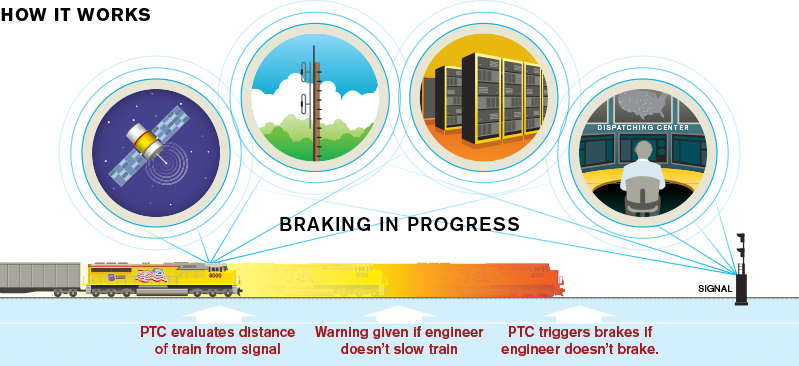
Innovation
LONG RAIL IS A GAME CHANGER
Union Pacific is the rail industry's first company to import long rail from Japan to its custom facility at the Port of Stockton, California, setting a new standard for rail reliability.
Full appreciation of the milestone requires a historical perspective. America's first railroads were constructed by bolting together 16-foot-long sections of steel rail. The bolted areas were structurally the weakest part of the rail, having the potential to break and cause a derailment. By the 1940s, steel companies began manufacturing longer sections fused together in welding plants to create quarter-mile-length segments. A great advancement over bolted rail, the welds strengthened the track structure.
By the 1980s, head-hardened rail was developed by cooling steel at a rate that provided additional strength. The new standard section became 80 feet, requiring 17 welds to create a quarter-mile length. Longer rail sections continued to be developed but were not as strong.
During this time, Union Pacific, Nippon Steel of Japan and Sumitomo Metal Corporation began discussing a revolutionary idea – manufacturing and shipping high-strength, head-hardened continuous-cast rail in 480-foot-long sections. With access to long rail, only two welds are needed to create quarter-mile lengths. This new system reduces welds by 88 percent, creating a more reliable network.
Implementation required innovation in every aspect of the process. Sumitomo designed “Pacific Spike,” the first ship in the world serving as a long rail shuttle for Union Pacific. The Port of Stockton's 25-acre, $18 million welding facility is equipped with a special overhead crane to lift the rail. It also features three tracks, two bridges, custom storage and welding facilities designed to accommodate the additional rail length.
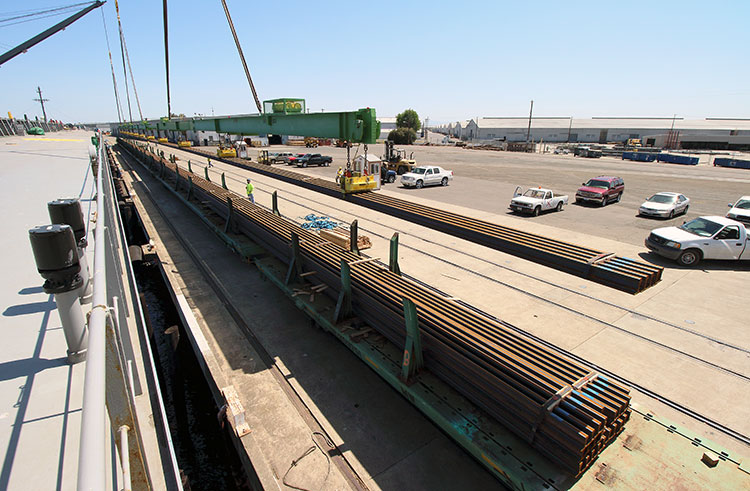
Union Pacific is the first railroad to implement 480-foot sections of long rail that improve reliability.
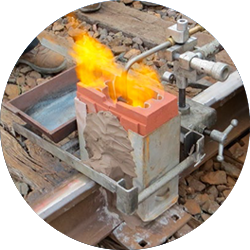
NEW WELDING TECHNOLOGY
Thermite head repair welds are a new technology that lowers the risk of rail defects in our track repair process. Specially trained welding teams use thermite head repair welds to fix internal flaws discovered by detector cars, which perform electronic track inspections. Instead of replacing an entire section of rail, welding teams grind down the rail head, remove the defect and leave the remainder of the rail intact. The process requires one weld instead of two, reducing installation time and eliminating alignment issues. Thermite head repair welds are an example of continuous efforts to make Union Pacific's rail lines stronger and safer.
Photo: Internal rail flaws are repaired without removing an entire section of rail with thermite head repair welding technology. This lowers the risk of rail defects in the track repair process.
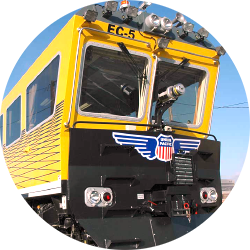
DETECTOR CARS
Union Pacific has two self-propelled track geometry inspection vehicles capable of performing a variety of electronic track inspections at speeds of up to 70 mph. A three-person crew operates the 90-footlong vehicle and performs inspections using 11 computer systems that gather data from lasers measuring track surface, rail wear and tunnel elements. On-board computers use GPS systems to accurately record and pinpoint exact repair locations. Track maintenance crews follow the inspection vehicle and make repairs as needed. The realtime data also is used to schedule track improvement projects. The two new vehicles join 22 Union Pacific-owned ultrasonic rail-flaw detection vehicles designed to “look” inside rails to find flaws undetectable by the human eye.
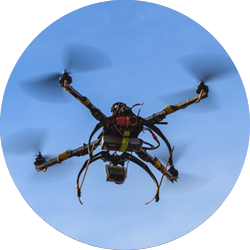
DRONE OPPORTUNITIES
The Federal Aviation Administration granted Union Pacific an exemption to use drones for aerial data collection, bringing us closer to enhancing emergency response efforts at derailments. Drones also could be used to obtain aerial images of rail infrastructure and perform bridge inspections. We are finalizing our drone deployment process, including preparing qualified pilots.
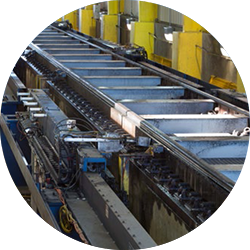
ULTRASONIC WHEEL-DEFECT DETECTION
Union Pacific is an industry leader in developing and testing new technology that helps improve mechanical inspections. Wayside detection systems automate inspections and look for defects in ways humans cannot, including analyzing wheels for internal cracks or flaws. These inspections are especially critical for cars carrying heavy loads that exert greater stress on wheels.
Our ultrasonic wheel-defect detection house in North Platte, Nebraska, is the world's first facility that uses ultrasound technology to inspect wheels on a moving train. Since this technology was implemented five years ago, we have identified and removed about 75 defective wheels annually that otherwise would have gone undetected.
Photo: Ultrasonic wheel-defect detection identifies internal cracks or defects inside wheels on moving trains and reduces derailments caused by broken wheels.
Hazardous Materials and Chemical Risk Reductions
We take our responsibility to safely ship all freight seriously. Our goal is to deliver every car safely while being prepared to respond in the unlikely event of an accident. Union Pacific's Environmental Management Group includes a Hazardous Materials Management Group, consisting of highly trained experts in hazardous material transportation safety, securement and response. Union Pacific meets stringent certification requirements under the American Chemistry Council's Responsible Care Management System program, demonstrating our commitment to safely handling hazardous materials.
public emergency responders trained in 2015.
customer tank car inspections conducted in 2015.
first responders invited to use the AskRail application since its introduction in 2014. AskRail allows first responders to use a tank car's identification number to determine the car's contents.
firefighters sponsored to attend a specialized crude-by-rail training program, bringing the total to more than 500 since the program's inception in 2004.
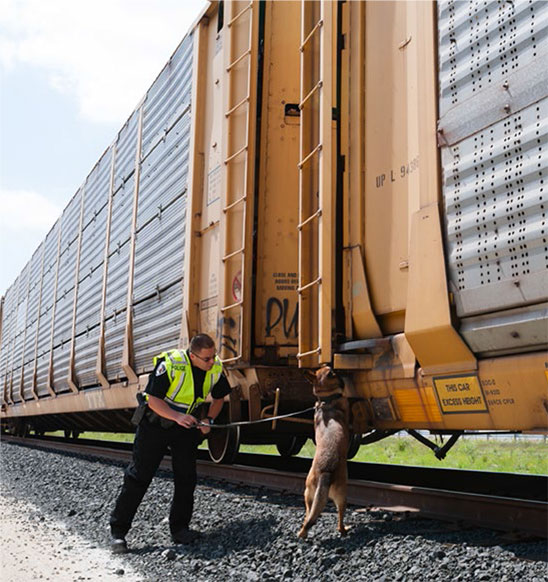
Special Agent Raymundo Velarde and his K-9 partner, Bizi, inspect a train in San Antonio.
Safety through Security
The Union Pacific Police Department meets the most stringent law enforcement standards and is certified by the Commission on Accreditation for Law Enforcement Agencies, considered the gold standard in public safety accreditation.
Our highly trained special agents use security monitoring technology that provides 24-hour intruder detection capabilities to protect critical infrastructure. Union Pacific also coordinates security efforts with U.S. Customs and Border Protection (CBP), the U.S. Coast Guard, the Federal Bureau of Investigation, the Central Intelligence Agency, the Department of Homeland Security, the Transportation Security Administration and local law enforcement. Union Pacific was the first U.S. railroad named a partner in the Customs-Trade Partnership Against Terrorism, a CBP program designed to develop, enhance and maintain security processes throughout the global supply chain.

